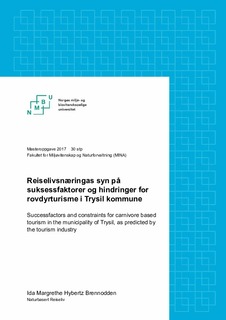| dc.contributor.advisor | Aas, Øystein | |
| dc.contributor.advisor | Krange, Olve | |
| dc.contributor.author | Brennodden, Ida Margrethe Hybertz | |
| dc.coverage.spatial | Trysil, Norway | nb_NO |
| dc.date.accessioned | 2017-11-28T14:24:15Z | |
| dc.date.available | 2017-11-28T14:24:15Z | |
| dc.date.issued | 2017 | |
| dc.identifier.uri | http://hdl.handle.net/11250/2468283 | |
| dc.description.abstract | Trysil kommune i Hedmark har både sterke tradisjoner for bruk av utmarka, et godt utviklet reiseliv og bestander av alle de fire store landlevende skandinaviske rovdyra. I semistrukturerte intervjuer ble representanter fra reiselivsnæringa i Trysil bedt om å peke ut suksessfaktorer og hindringer for rovdyrturisme. Ett intervju ble gjennomført som et gruppeintervju med tre av bedriftens ansatte.
Til sammen kom informantene med 13 suksessfaktorer og 12 hindringer. Kategoriene var i stor grad i overenstemmelse med dem beskrevet av Lundberg og Fredman (2012) og Ednarsson (2006). I tillegg til kategoriene basert på teorien, ble fem nye kategorier opprettet: destinasjonsprofil, sosialt ansvar, forventninger, timing og satsning. Informantene kom med forslag til ei målgruppe for rovdyrturisme, beskrev en ideell entreprenør og guide og foreslo hvordan å utforme en rovdyropplevelse. Informantenes forslag til ulike rovdyrprodukter beskrives etter kategoriene fra Reynolds og Braithwaite (2001). Av de fire store rovdyra ble bjørn (Ursus arctos) antatt å være best egnet for rovdyropplevelser, da den var ansett som mindre konfliktfylt enn ulv (Canis lupus) og mer utbredt og mindre sky enn jerv (Gulo gulo) og gaupe (Lynx lynx).
Informantene så for seg at lokalbefolkninga i stor grad kunne være negativ til rovdyrturisme, da det kunne bli sett på som å gjøre knefall for dagens rovdyrpolitikk. Selv om tryslingene ble ansett for å være heterogene i holdningene til rovdyr og rovdyrturisme, kunne fellesskapsfølelse og lojalitet gjøre at negative holdninger virket dominerende. Rovdyr ble ansett for å være en trussel mot tradisjonell bruk av utmarka, og indirekte å bidra til fraflytting i kommunen. For å gjøre holdningene til rovdyrturisme mer positive, ble det foreslått å aktivt inkludere lokalbefolkninga i utviklinga av produktet og å formidle positive og negative sider ved rovdyr for kunder. Tiltakene diskuteres i lys av Scheyvens' (1999) rammeverk for å styrke lokalsamfunn og Innovasjon Norges kriterier for bærekraftige reisemål. Det ser ut til å være et potensiale for å utvikle mer rovdyrturisme i Trysil og i Norge, men det krever at det tas hensyn til lokales behov og meninger. | nb_NO |
| dc.description.abstract | The municipality of Trysil, located in Hedmark county, is a popular tourist destination with strong traditions. It also has populations of all the four of the large Scandinavian carnivores. Representatives from the tourism industry were asked to discuss what success factors and constraints they could face when starting and developing carnivore based tourism. The interviews were semi structured. One interview took place as a group interview with three employees, while the others were one-to-one.
The representatives predicted 13 success factors and 12 constraints for carnivore based tourism. These categories have a lot in common with those predicted by Lundberg and Fredman (2012) and Ednarsson (2006). There were five new categories added; destination profile, social responsibility, expectations, timing and dedication. The informants described a potential carnivore tourist, an ideal entrepreneur and guide, and examples of carnivore based products. The informants’ suggestions to different carnivore based products are described using the categories from Reynolds og Braithwaite (2001). The bear (Ursus arctos) was assumed to be the animal most suited for carnivore tourism, as it is less controversial than the wolf (Canis lupus), and less shy and more common than the lynx (Lynx lynx) and the wolverine (Gulo gulo).
The informants believed the local community might be partially opposed to carnivore tourism, as it could be interpreted as giving in to current carnivore politics. Even though the local community was thought of as being heterogeneous in their attitudes to carnivores and carnivore tourism, a sense of fellowship and loyalty could promote mostly negative attitudes to carnivore tourism. Carnivores were thought of as a threat to the tradistional use of the forest, and as an indirect cause of depopulation. Taking a social responsibility could help make the local communities attitudes more positive. The informants suggested to include the community in decision making, and to tell customers about the positive and negative consequences of having carnivores in an area. These measures are discussed using Scheyvens (1999) framework for empowering local communities, and Innovation Norway’s criteria for sustainable tourism. Carnivore tourism seems to have a potential in Trysil and Norway, but the local community has to be respected and included. | nb_NO |
| dc.language.iso | nob | nb_NO |
| dc.publisher | Norwegian University of Life Sciences, Ås | nb_NO |
| dc.rights | Attribution-NoDerivatives 4.0 Internasjonal | * |
| dc.rights.uri | http://creativecommons.org/licenses/by-nd/4.0/deed.no | * |
| dc.subject | naturbasert reiseliv | nb_NO |
| dc.subject | rovdyrbasert turisme | nb_NO |
| dc.subject | wildlife tourism | nb_NO |
| dc.subject | empowerment | nb_NO |
| dc.subject | bærekraftig reiseliv | nb_NO |
| dc.subject | suksessfaktorer og hindringer | nb_NO |
| dc.title | Reiselivsnæringas syn på suksessfaktorer og hindringer for rovdyrturisme i Trysil kommune | nb_NO |
| dc.title.alternative | Successfactors and constraints for carnivore based tourism in the municipality of Trysil, as predicted by the tourism industry | nb_NO |
| dc.type | Master thesis | nb_NO |
| dc.subject.nsi | VDP::Samfunnsvitenskap: 200 | nb_NO |
| dc.source.pagenumber | 72 | nb_NO |
| dc.description.localcode | M-REIS | nb_NO |

